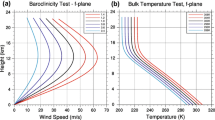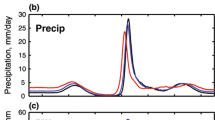Abstract
Moist potential vorticity (MPV) and its generation may be important in the development of mesoscale structures such as rainbands within cyclones. In an adiabatic and frictionless flow, MPV generation is possible if the flow is three-dimensional and the air is unsaturated. Moist potential vorticity can be generated through the combined effects of gradients in the potential temperature and moisture fields. The diagnosis of MPV generation in an extratropical cyclone was performed with the ECMWF objectively analyzed fields for a system that developed during February 1992. It was found that at various stages during the development of the cyclone, negative MPV was generated: at the north end of the cold front; along the occluded front and the cold front; and in the region of the warm core. This pattern of negative MPV generation is in excellent agreement with the predictions of previous theoretical and numerical studies. After the cyclone ceased to deepen, the region of negative MPV generated in the cyclone was horizontally advected into a saturated area. The area of negative MPV generated both along the occluded front in this case study and in the region of the bent-back warm front in a numerical simulation showed a mesoscale structure with a width of about 200–500 km. It was found that the intrusion of moist or dry air into baroclinic zones was important for MPV generation. In addition, baroclinicity increase (adjacent to the area of condensation) in the regions of high moisture gradients led to significant MPV production.
Similar content being viewed by others
References
Anthes, R.A., E.-Y. Hsie and Y.-H. Kuo (1987), Description of the Penn State / NCAR Mesoscale Model Version 4(MM4), NCAR Technical Note, NCAR / TN-282, 66pp.
Anthes, R. A. (1990) Recent applications of the Penn State/NCAR mesoscale model to synoptic, mesoscale, and climate studies, Bull Amer. Meteor. Soc., 71: 1610–1629.
Bennetts, D. A. and B. J. Hoskins (1979), Conditional symmetric instability - a possible explanation for frontal rainbands, Q.J. R. Met. Soc., 105: 945–962.
Bennetts, D. A. and P. Ryder (1984), A study of mesoscale convective bands behind cold fronts, Part I: Mesoscale organization, Q. J. R. Met. Soc., 110: 121–145.
Bennetts, D. A. and J. C. Sharp (1982), The relevance of conditional symmetric instability to the precipitation of mesoscale frontal rainbands, Q. J. R. Met. Soc., 108: 595–602.
Bond, N. A. and R. G. Fleagle (1985), Structure of a cold front over the ocean, Q. J. R. Met. Soc., 111: 739–759.
Browning, K. A. (1990), Organization of clouds and precipitation in extratropical cyclones, Extratropical cyclones, The Erik Palmen Memorial Volume, C. W. Newton and E. Holopainen, Eds. Amer. Meteor. Soc., 132
Cao, Z. and H.-R. Cho (1995), Generation of moist potential vorticity in extratropical cyclones, J. Atmos. Sci., 52: 3263–3281.
Carlson, T. N. (1980), Airflow through midlatitude cyclones and the comma cloud pattern, Mon. Wea. Rev., 108: 1498–1509.
Clough, S. A. and R. A. A. Franks (1991), The evaporation of frontal and other stratiform precipitation, Q. J. R. Met. Soc., 117: 1057–1080.
ECMWF (1992), The description of the ECMWF / WCRP Level III-A global atmospheric data archive, Available from the European Center for Medium Range Weather Forecasts.
Emanuel, K. A. (1979), Inertial instability and mesoscale convective systems, Part I: Linear theory of inertial instability in rotating viscous fluids, J. Atmos. Sci., 36: 2425–2449.
Hanesiak, J. M., R. E. Stewart, and K. K. Szeto et al. (1997), The structure, water budget and radiational features of a high latitude warm front, J. Atmos. Sci. (in press).
Hobbs, P. V. (1978), Organization and structure of clouds and precipitation on the mesoscale and microscale in cyclonic storms, Rev. Geophys. Space Phys., 16: 741–755.
Houze, R. A., P. V. Hobbs, K. R. Biswas and W. M. Davis (1976), Mesoscale rainbands in extratropical cyclones, Mon. Wea. Rev., 104: 868–878.
Innocentini, V. and E. D. S. C. Neto (1992), A numerical study of the role of humidity in the updraft driven by moist slantwise convection, J. Atmos. Sci., 49: 1092–1106.
Matejka, T. J., R. A. Houze and P. V. Hobbs (1980), Microphysics and dynamics of clouds associated with mesoscale rainbands in extratropical cyclones, J. Roy. Meteor. Soc., 106: 29–56.
Miller, J. E. (1948), On the concept of frontogenesis, J. Meteor., 5: 169–171.
Parsons, D. B. and P. V. Hobbs (1983), The mesoscale and microscale structure and organization of clouds and precipitation in mid-latitude cyclones. XI: Comparisons between observational and theoretical aspects of rainbands, J. Atmos. Sci., 40: 2377–2397.
Persson, P. O. G. (1995), Simulations of the potential vorticity structure and budget of Fronts 87 IOP8, Q. J. R. Met. Soc., 121: 1041–1081.
Petterssen, S. (1936), Contribution to the theory of frontogenesis, Geophjys. Pubi, 11.
Raga, G. B., R. E. Stewart and J. W. Strapp (1994), Mesoscale structure of precipitation bands in a north Atlantic winter storm, Mon. Wea. Rev., 122: 2039–2051.
Reuter, G. W. and M. K. Yau (1990), Observations of slantwise convective instability in winter cyclones, Mon. Wea. Rev., 118: 447–458.
Sanders, F. (1955), An investigation of the structure and dynamics of an intense surface frontal zone, J. Meteor., 12: 542–552.
Shutts, G. J. (1990), Dynamical aspects of the October storm (1987), A study of a successful fine-mesh simulation, Q. J.R.Met. Soc., 116: 1315–1347.
Stewart, R. E. (1991), Canadian Atlantic Storms Program: Progress and plans of the meteorology component, Bull. Amer. Meteor. Soc., 72: 364–371.
Trenberth, K. E. and J. G. Olson (1988), An evaluation and intercomparison of global analyses from the National Meteorological Center and the European Center for Medium Range Weather Forecasts, Bull. Amer. Meteor. Soc., 69: 1047–1056.
Trenberth, K. E. and A. Solomon (1993), Implications of global atmospheric spatial spectra for processing and displaying data, J. Climate, 4: 531–545.
Author information
Authors and Affiliations
Corresponding author
Additional information
Corresponding author: Dr. Zuohao Cao, Climate Processes and Earth Observation Atmospheric Environment Service, 4905 Duffrin Street, Downsview, Ontario, Canada M3H 5T4.
Rights and permissions
About this article
Cite this article
Cao, Z., Moore, G.W.K. A diagnostic study of moist potential vorticity generation in an extratropical cyclone. Adv. Atmos. Sci. 15, 152–166 (1998). https://doi.org/10.1007/s00376-998-0036-2
Received:
Issue Date:
DOI: https://doi.org/10.1007/s00376-998-0036-2




